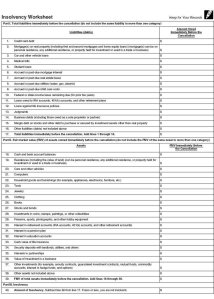Home » DEBT RELIEF » BANKRUPTCY
Category Archives: BANKRUPTCY
IRS Tax Tip 2013-31: Important Facts about Mortgage Debt Forgiveness
If your lender cancelled or forgave your mortgage debt, you generally have to pay tax on that amount. But there are exceptions to this rule for some homeowners who had mortgage debt forgiven in 2012.
Here are 10 key facts from the IRS about mortgage debt forgiveness:
1. Cancelled debt normally results in taxable income. However, you may be able to exclude the cancelled debt from your income if the debt was a mortgage on your main home.
2. To qualify, you must have used the debt to buy, build or substantially improve your principal residence. The residence must also secure the mortgage.
3. The maximum qualified debt that you can exclude under this exception is $2 million. The limit is $1 million for a married person who files a separate tax return.
4. You may be able to exclude from income the amount of mortgage debt reduced through mortgage restructuring. You may also be able to exclude mortgage debt cancelled in a foreclosure.
5. You may also qualify for the exclusion on a refinanced mortgage. This applies only if you used proceeds from the refinancing to buy, build or substantially improve your main home. The exclusion is limited to the amount of the old mortgage principal just before the refinancing.
6. Proceeds of refinanced mortgage debt used for other purposes do not qualify for the exclusion. For example, debt used to pay off credit card debt does not qualify.
7. If you qualify, report the excluded debt on Form 982, Reduction of Tax Attributes Due to Discharge of Indebtedness. Submit the completed form with your federal income tax return.
8. Other types of cancelled debt do not qualify for this special exclusion. This includes debt cancelled on second homes, rental and business property, credit cards or car loans. In some cases, other tax relief provisions may apply, such as debts discharged in certain bankruptcy proceedings. Form 982 provides more details about these provisions.
9. If your lender reduced or cancelled at least $600 of your mortgage debt, they normally send you a statement in January of the next year. Form 1099-C, Cancellation of Debt, shows the amount of cancelled debt and the fair market value of any foreclosed property.
10. Check your Form 1099-C for the cancelled debt amount shown in Box 2, and the value of your home shown in Box 7. Notify the lender immediately of any incorrect information so they can correct the form.
Use the Interactive Tax Assistant tool on IRS.gov to check if your cancelled debt is taxable. Also, see Publication 4681, Canceled Debts, Foreclosures, Repossessions and Abandonments. IRS forms and publications are available online at IRS.gov or by calling 800-TAX-FORM (800-829-3676).
Additional IRS Resources:
Interactive Tax Assistant tool
Publication 4681, Canceled Debts, Foreclosures, Repossessions and Abandonments
Mortgage Forgiveness Debt Relief Act and Debt Cancellation
Form 982, Reduction of Tax Attributes Due to Discharge of Indebtedness
IRS YouTube Videos:
Mortgage Debt Forgiveness – English | Spanish | ASL
Canceled Debts, Foreclosures, Repossessions, and Abandonments
Insolvency
If you have qualified real property business indebtedness that is cancelled, you can elect to exclude this from income. However, the debt must meet the following criteria:
1) It must be incurred or assumed in connection with real property used in a trade or business.
2) It must be secured by such real property.
3) It must be incurred or assumed at either of the following times:
a. Before 1993
b. After 1992, if the debt is either (i) qualified acquisition indebtedness (defined below), or (ii) debt incurred to refinance qualified real property business debt incurred or assumed before 1993 ( but only to the extend the amount of such debt does not exceed the amount of debt being refinanced.)
4) It must be debt to which you elect to apply these rules
Qualified principal Residence indebtedness
What’s new for 2008
The qualified principle residence indebtedness exclusion has been extended. The extension includes debts discharged after 2006 and before 2013.



